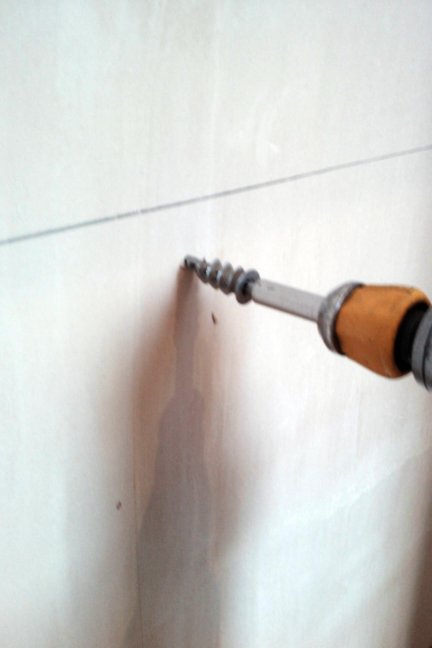Super Strong Plasterboard Fixings!
How to screw to plasterboard walls, for hand rails, shelves, cabinets,
flat screen TV's etc.
There are several different ways to get good strong plasterboard fixings when attaching things to hollow gypsum / drywall plasterboard (also called Gyproc) and stud-work walls.
Hollow stud-work walls are easy to fix to if there's a stud exactly where you want to get a nail or screw, and you can use a stud finder to easily and accurately locate the studs. Another way to find where the studs are is to look for where the nail holes have been filled in the skirting board or by tapping the wall.
The Gypsum in plasterboard is particularly soft and brittle, and so specific fixings are needed in order to get a decent enough hold that won't pull away. Rawl plugs used for masonry or nails are useless for getting a secure fixing in plasterboard walls.
There are loads of different plasterboard plugs and screws available depending on the weight of what you want to fix. Plasterboard fixings are available that you can use for fixing things like shelf battens, curtain poles, flat screen TV brackets and even kitchen cabinets to the wall!
Here is a list of the best fixings I carry and use (click on one to see pictures), arranged in order of the strongest one first;
How to fix using RedDriver plasterboard fixings
I hold whatever it is i'm fixing to the wall in the exact position I want it. Drill a clearance hole (slightly larger than the screws threads) through the timber and plasterboard. I do this all the way along or everywhere I need a screw and there isn't a timber stud.
 |
 |
Then remove the timber and wind a Redidriver into each hole until it is flush with the board. Be careful when winding them in, keep it straight and if you have to hold the fixing use a slow speed so you don't chew your fingers up.

Replace the timber and screw into the plugs.
How to fix a TV bracket to plasterboard / drywall walls
You can get a much stronger fixing if you are attaching something large, like a radiator. This is also the method I use how to fit a flat screen TV bracket to a plasterboard wall. It's sods law that there won't be a timber stud in the wall where you need it!
If you can get good fixings into one stud in the wall then you can use the heavy duty plasterboard fixings (anchors described above) to hold the other side of the bracket with. If not, you'll need to cut a section of the drywall out to get a block of timber into the hollow wall to fix to (there's a similar detailed description with pictures at the half newel page).
I cut a hole in the board where it will get covered up by whatever i'm fixing so I can put a lump of timber behind. You have to do this with large objects or you risk ripping the fixing out of the wall otherwise. This is especially important with things like stair parts because people are going to grab and pull on the hand rails, a normal drywall fixing will get ripped out of the wall after a while and then be difficult to repair or reattach to.
Step 1: First, I mark a faint line around the object you want to attach. Remove it, and mark a line about half an inch inside the other. You need to make a judgement on how much board to cut out, enough to get your timber in where the best place for a screw is.
Step 2: Next, use a pad saw to cut a section of board out.
Step 3: Mark a line at the centre of the piece of timber you are putting in the wall so when it's in there you can centralise it in the hole. The screw also gives you someting to hold the timber in pace with your claw hammer while you screw through the plasterboard to hold it in place.
Step 4: Finally screw the piece of board that you removed back in place and its ready to fix to.
If I'm fixing a TV bracket I cut a hole that will fall inside the bracket when it's on so the hole is covered. If it's an adjustable bracket and what I cut out will be seen I trim every side of the hole and fill it with easifill (fine filler made by the same people that make plaster/plasterboard - gypsum).
Fixing skirting boards to plasterboard walls
Plasterboard fixings related pages
More finish carpentry fixings I usePopular drill sizes
Have a comment or question about getting secure plasterboard fixings?